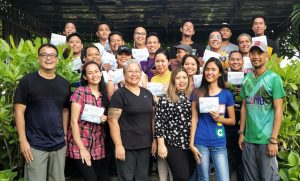
The island of Camiguin is more than just volcanoes that razed its old Guiob church and moved the community cemetery to sea in 1871. More than its calamitous past, Camiguin is home to affable people who have resided in the island for centuries.
Our visit to the province early this week for a photojournalism workshop afforded us to take a peek at its olden days as we explored the streets of downtown Mambajao.
“This is where most the pioneering families of Camiguin built their homes. Most of them came from Bohol, and as they moved here, they also brought with them a piece of the Boholano culture, customs as well as cuisines,” said Atty Dante M Aparte, the province’s sprightly legal officer, who also joined the workshop’s photo walk.
From Rizal Street, we traversed the quite thoroughfare of Mabini, passing by the old abodes of the Neris, Corderos, Chans, Luspos and Borromeos (our host, provincial tourism officer Candice Borromeo-Dael is a scion of the latter). The said families have helped shape Camiguin’s past and continues to do so in the present.
We noticed that some of the old abodes were transformed in shophouses, where the ground level were used by the family – or rented out to local entrepreneurs – for commercial use.
Others were left to caretakers as the younger members of the families have opted to seek opportunities either nearby in Cagayan de Oro or abroad.
We also walked by the famous Viola’s, owned by the Aranas family, the oldest halo-halo salon in town. Viola was named of one of their daughters.
“In fact, they were the first to bring an ice drop maker in the island. This was back in the 50s,” added Atty Aparte.
One of the stops of our stroll was at the Old Mambajao Fountain, located in a roundabout near the town’s main mercado (market), built in 1914. The National Museum has declared it as one of the country’s Important Cultural Property for “having exceptional cultural, artistic and historical significance to the Philippines.”
Not too far are two other iconic Mambajao structures: the old parola (lighthouse), which used to guide incoming ships in the former site of the island’s main port before it was transferred to Benoni town, and the Heroes’ Shrine, a memorial dedicated to the soldiers of World War l and ll.
We also made a stop at San Nicolas de Tolentino Parish, built in 1892 under Fr. Dionision Pueyo, then reconstructed in 1935 under Fr. John Pollock.
Our photo walk became a virtual heritage tour, thanks to Atty Aparte’s very informative commentaries that gave us a different perspective of Camiguin.
The photo walk was part of the two-day photojournalism workshop conducted by award-winning Davao-based photographer Rhonson Ng and this writer.
“Our office initiated the workshop primarily to allow our employees, representing various agencies of the province, to improve their photography and documentation skills,” said Borromeo-Dael.
Around 30 employees participated in the two-day workshop held at the Provincial Sanguniang Panlungsod session hall and Balai sa Baybay Resort.

